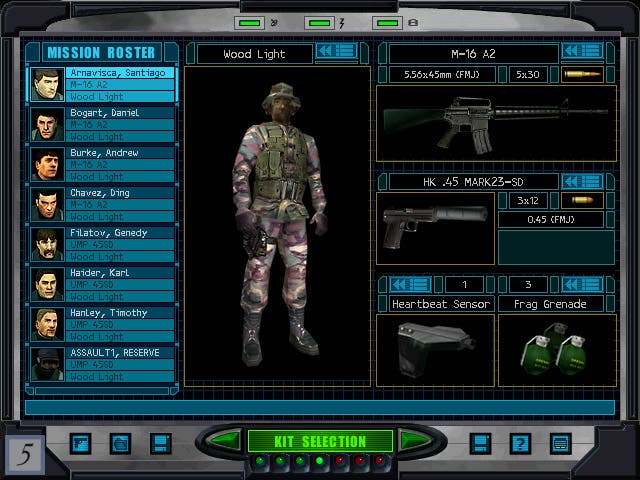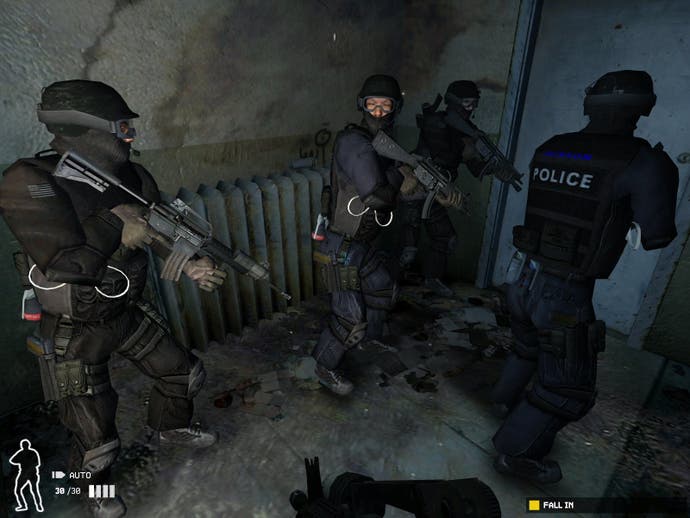Where did all the strategy go?
Looking back at a genre that's seemingly been forgotten.
About 10 years ago, a wonderful genre of video games began to die. Seemingly crushed by the twin forks of Call of Duty and Battlefield, the rich palette of the strategy FPS genre has now seemingly atrophied down to a single game: Arma 3. In memoriam, we were offered Rainbow Six Vegas and its sequel, and then almost nothing. An entire genre, which was once rich and vibrant and thought-provoking and important, has slipped away, leaving a singular behemoth to carry the torch, albeit with an emphasis on the great outdoors. Gone were games that celebrated tactical thought and restraint in combat. Gone were games that promoted planning (with dedicated planning interfaces). Gone were games with a dedicated button for shouting. Gone were games where the stakes were so high, the Rambo run-and-gun method was akin to button-mashing in Streetfighter.
Bohemia's Arma series may be brilliant in its breadth and scope, but it's no substitute for the tight, fraught urban and industrial confines of Rainbow Six or Sierra's SWAT 3. The tactical FPS genre was founded in the spec-ops pornography of Tom Clancy and his rainbows, but the fetishisation of elite soldiers and the end-of-days urgency driving Clancy plots never detracted from the severe, hyper-consequential gameplay - a weight that Clancy himself wanted his games to carry. If you got it wrong, your team died, and you could get it very wrong on first contact with the enemy. This colossally enlarged risk demanded a level-headed strategic approach. There were no safety-net health packs or odds-balancing megaweapons to be found in 1998's Rainbow Six. Instead, there's respect for the damage a single bullet can do, and what one unaccounted-for AI terrorist can do to the best laid plans of seasoned players.
For someone raised on Wolfenstein 3D, Doom and Goldeneye, it was a revelation. This was much more the "real deal", exposing everything that came before it for the cartoon infantilism it really it is. Today, the original Rainbow 6 is rudimentary in the extreme, but it still illuminates that dirty truth - that video games trivialise gunplay to shocking degrees. It's often far beyond the dalliances of TV or cinema and gleefully flies into hyperbole so extreme, a player can walk off a landmine or artillery shell in the majority of FPS games or, in the case of Far Cry 2 and 3, pull a 7.62 bullet out of their shin and just carry on shooting (while also on fire and shrugging off a crazed animal). Rather than bang on about the failings and lack of real-world consequence in the modern shooter, let's contemplate three of the strategy FPS genre's greatest exponents.
Rainbow Six: Rogue Spear

A sequel to the original Rainbow Six, Rogue Spear carried the tactical flag into new locales with its main thread and supplemental add-on packs. A hostage rescue in a London Underground station sits alongside a superbly-realised airliner siege, some 7 years before Call of Duty 4's Mile High Club, with many more hostage rescues and infiltration assaults to test your mettle. In command of a large team and with a control interface based on simple go-codes, you could set up glorious set-piece tactical victories, 20 times an hour, provided you knew the lay of the land and kept clear of terrifyingly plausible kill-zones. The beauty was in being able to go deep in the planning interface and automate an entire run, or play more reactively and hands-on by positioning each team member manually, then triggering breach/snipe/assault codes on the fly.
Up to 2003's Raven Shield, Rainbow Six was the gold standard for the strategic FPS, but lost its hard-edged tactical sheen with the Vegas titles. Not all was lost, however. Rainbow Six Vegas 2 had the best XP system ever seen (with unified progression and classing for single and multiplayer), and had no problem allowing you to play as a woman or as a man. Even if the story was insanely silly and the action a bit more on the light side, it provided a sprinkle of the old Rainbow Six magic for a generation in transition, particularly in co-op Terrorist Hunt. It remains to be seen if the upcoming Rainbow Six: Seige will mark a return to the original's stern-and-strict restraint, but it's doubtful that a modern AAA title will let you be as negligent as to run your entire team down a single staircase under a merciless AI sniper's gaze. That said, I have undertaken few acts of gaming revenge as sweet as finding out where that sniper was hiding and shooting him in the back with a shotgun.
Hidden & Dangerous 2

Before being dragged into the cinematic mire of the Mafia titles, Illusion Softworks developed one of the best strategy shooters of all time. Set in World War 2 and based on real missions fought by real people, Hidden & Dangerous 2 is a world-hopping titan of taut stealth-oriented action, marred by the occasional WTF moment (such as a mounted-gun sequence on a plane flying across a desert). Starting with a bafflingly long and involved tutorial in Blighty, Hidden & Dangerous 2 somehow manages to touch on every theatre of WW2 aside Russia, with the player guiding a four-man squad through Norway, Normandy, North Africa, Burma and various parts of Europe. You might be infiltrating a research bunker or booby-trapping an entire village so that four soldiers can hold off an army. Or you might be crawling through Burmese tunnels or picking your way through a crashed Nazi train, or commandeering a Panzer in an late-war Germany, or securing an iceberg U-boat base.
Whatever you're doing, it needs a lot of waiting and watching, and a good knowledge of what your team can handle. The historical detail is consistently fantastic, as is the attention paid to the design - every bit of team dialogue has a whispered version for stealth mode, which was amazing at the time. Combat is commonly quick and ruthless, and surgically clean if you're playing well, allowing for all sorts of lure-and-bait ambush tactics. Deeper still is the attachment to your team. You pick them at the start and can carry them through the entire campaign, creating all sorts of gloried moments with your boys, like when Arthur Muncie saved the day with a silenced sten gun in that Norwegian fjord, when all we had to do was sink the battleship Tirpitz without anyone noticing. Arthur miraculously shot an SS captain just before he sounded a mission-failing alarm, got a nifty hat into the bargain, and clearly deserved a medal.
SWAT 3

Sierra's first foray into FPS territory for its isometric SWAT series was a unique, astonishing success. With an overbearing emphasis on correct procedure, players run through a slightly dodgy domestic terrorism narrative that encompasses flashpoints like bank robberies, hostage situations and home invasions, across a fabulous range of detailed locales. Locales with a gritty and utterly convincing sense of the authentic. SWAT 3 was a lot more sim-like than Irrational's lauded (but more sensationalist) SWAT 4 and there was nothing like whispering "breach, bang and clear" and seeing your AI compatriots breach, bang and clear a room of awful baddies with deft efficiency. Then you could report in all the dead (or if you're pro, captured) baddies and collect their weapons for maximum SWAT points.
This unique reporting angle added a certain contemplative air. After all the bullets had been fired and all the baddies were on the floor, radioing in the remains gave a real weight to your judicious carnage. I'll never forget the attention to detail either; after sorting out a nasty bank robbery, a criminal that was previously writhing on the floor had gone still when I came to report him in. The audio sample coldly announced "this one's bled out". This kind of detail underlined the respect that Sierra had for the real-world SWAT discipline, and concurrently lead to you playing with the same degree of respect for procedure, even if the shout button was just too fun to spam (but could defuse an angered bystander without having to chuck in some CS gas). You weren't a soldier, but a police officer, and the urge to subdue with minimal force (and maximum points) became a moral quest. No other FPS has gone to such lengths to engender restraint.
***
Of course, I'm missing out a lot of great titles here. Games like Full Spectrum Warrior, SOCOM, Vietcong and Delta Force are long forgotten now, but they both shared the same values as the above. Even the original Spec Ops tried to pull it off. The attention and thought in them all - to detail, to consequence, to allow you to feel afraid of a single bullet and a single enemy, to have no safety net other than the quickload, to let you fail horrifically, seems like a discovering a lost age of cerebral action gaming for actual adults, rather than rollercoaster booms and bangs for amorphous generic gamers of questionable maturity. These games were about finding the balance between twitch response and strategic thought, and promoted the idea that the two weren't mutually exclusive, but in fact valuably entertaining and rewarding, whilst being surprisingly insightful into the world of the professional shooter - and in a manner that only games can provide. I certainly got much more a sense of the truth of covert warfare while munging through the jungles of Hidden & Dangerous 2's Burma, terrified of every shifting shape, than I do from any pumped-up docu-drama re-enactment on TV.
As for why this genre faded into obscurity, it seems pretty obvious. Development costs demanding large returns is one thing, but the popularisation of Counter Strike-like multiplayer is likely the root. Counter Strike is barely a tactical FPS, but it's just enough to count, and its legacy in COD and Battlefield has spun out a thin thread of the tactical philosophy to more gamers than Rainbow Six ever could on its own. However, I can't be so diplomatic about the publisher response. When I look at where Ghost Recon started and where it ended up, I can only shake my head in dismay. Its decline into cinematic bro-team futuristic battle action was indicative of a generational shift. Such was the march of popularisation by publisher demand perhaps, rather than the popularisation through actual merit that powered COD and Battlefield's rise.
I do wonder if the tactical-strategic FPS will ever return with its original rigour. Sniper Elite and ARMA may be our best hope these days, but perhaps a decent segment of a maturing COD audience will be receptive to more studious and cerebral games about warfare. As with the more puzzle-oriented isometric greats like the Jagged Alliance and Commandos titles, the strategy shooters still maintain a certain timelessness in their high-stakes tension and the concept certainly has plenty of mileage, as the bounteous range of mods for Arma (including Day Z) attest. Despite its tortuous development history, Rainbow Six: Siege is still something to look forward to, and I can only hope it re-ignites a fire that's been left smouldering for far too long.









